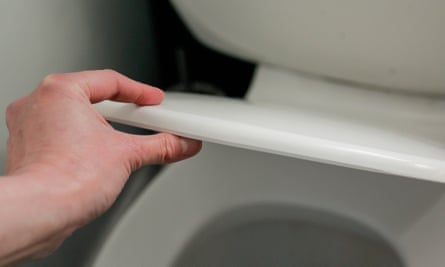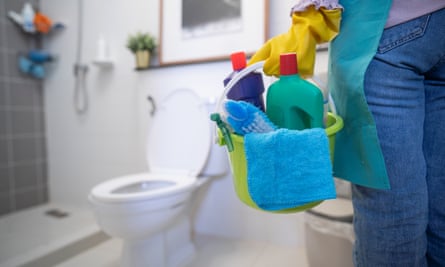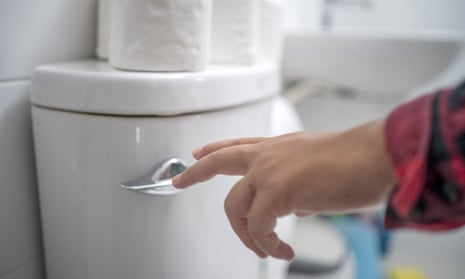How do you flush the toilet? Hopefully it wouldn’t be too much to presume that, after finishing up important bathroom business, you locate a button or handle and press it. But, according to research, the answer might be more complicated. By now we’re all well aware of the fact that, if bathrooms are a breeding ground for bacteria, the loo is their epicentre. On average, a toilet bowl contains 3.2m bacteria per square inch, rivalled only by the toothbrush holder. When we flush, we run the risk of spreading those bacteria around the room, and potentially all over ourselves, too.
For decades, debates over how we do our duty – or, more specifically, what we do afterwards – have divided nations, rearing up once more earlier this week. Does flushing a lidless toilet – and exposing ourselves to a “plume” of microscopic particles – make us sick, for example? And do you flush public toilets using your feet, as one 2013 survey asked? (Two-thirds of American respondents answered that yes, they do. A thought to ponder.)
So, how do we settle the right (and wrong) way to flush a toilet? Ann Russell, author of How To Clean Everything and TikTok’s favourite cleaning Auntie weighs in.

Should I always flush with the lid down?
“Essentially, yes – especially when you’ve had a poo,” Russell says, “because the flush can spray very fine particles and toilet water all over your bathroom.” A 2022 global review found that contaminated aerosol particles can travel as far as 1.5 metres away when the toilet is flushed and linger for up to six hours; the difference in the amount of bacteria spread when flushing with the lid up versus down is, according to a study from 2011, nearly 12-fold. “It’s best practice – though, let’s be honest here, it’s not going to kill you if you don’t.”
What if my toothbrush gets contaminated?
“Again,” says Russell, “it’s best to try to make sure the loo lid is closed to stop your toothbrush, or anything else, getting contaminated, but I have yet to hear of anyone being made ill by their toothbrush.” That’s despite your toothbrush hosting as many 1.2 million bacteria to begin with. “There are people who will say that it’s disgusting [if you expose your toothbrush to a flushing loo] but it’s probably not going to do you any real harm.”
Is there anything I should avoid chucking down the loo?
Yes, basically anything except toilet paper, says Russell. “Lavatory paper is specifically made to disintegrate very quickly in water, and designed not to block up our pipe work. Which is why I don’t like people using things such as kitchen towels. A kitchen towel is designed to have what’s called ‘wet strength’ so that when you wipe your kitchen counter, it holds together. Anything that’s not loo roll or human waste should never go down a lavatory.”
When should I avoid flushing?
In short, it’s up to each household – if you’ve just had a wee then there’s no real need to flush every time if the lid is kept down, says Russell. And there are compelling environmental reasons to abstain when possible, not least because most wastewater created by flush toilets (more than 80% worldwide) goes directly back into the environment with no treatment. There may be other reasons, too: “I live in a very small, compact house and the cistern for our loo is behind the panelling at the foot of my bed, so we have a strict rule that nobody flushes the toilet after I’ve gone to bed,” says Russell.
“This year has been a really clear example of the trouble that climate change is causing; our food production is likely to be massively affected. That means that, whereas right now we think we live in a wet country, where there’s lots of rain, there will come a time when we need to divert water that we’re profligately flushing down loos to help our food grow.”

So it changes if you live in a warmer or colder climate?
“Yes, some things change,” says Russell. “Take showering: if you’re in Finland or in the UK when it’s cold, you probably don’t need to shower quite as often as if you’re in, for example, the southern states of America. Bacteria are going to grow quicker in the warmth, so you’d be more likely to need to flush more, and perhaps use more bleach.”
Bleach is an essential for a fresh flush, then?
“No. In soft water areas, bleach is fine to clean toilets, but in hard water areas, you should avoid it all together. In hard water areas you need a bathroom cleaner with a limescale remover – but used together with bleach, that will release chloramine gas.” Russell has learned from experience. “I did it once: an elderly gentleman [whose house I was cleaning] put a bit of bleach down the loos so they would be hygienic for summer. The first thing I did was put Harpic down and inhale the gas – he thought he might have to call an ambulance; I was green, I could hardly breathe. I had to sit outside for half an hour.”
Does it matter how frequently you clean the loo?
“That, again, depends on your family. If it’s just you, or you and another adult, then once or twice a week is fine. If you’ve got younger kids then probably eight times a day.”
Any extra cleaning tips?
Never use wipes: “Use toilet paper, or a cloth that can go in a sanitising wash as soon as you’ve finished cleaning.”

Comments (…)
Sign in or create your Guardian account to join the discussion